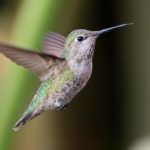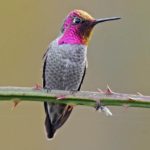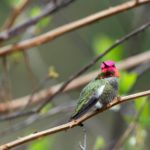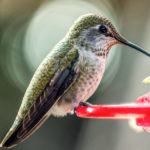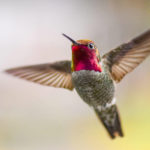Hummingbirds are native to Americas and they belong to the family of Trochilidae. There are around 328 known species of Hummingbird from which the smallest one is bee hummingbird which is from Cuba and the largest one is Giant Hummingbird which is from South America. Hummingbirds are very small and colorful birds having sparkling feathers. These birds can fly very fast and they can flap their wings for a very long time without getting tired. While flapping the wings, hummingbirds make a humming sound that is why they got this name.
Hummingbird Characteristics
- The wings flapping sound made by the Hummingbird while flying is so loud with high frequency that it can be easily audible to humans.
- Hummingbirds come in different colors of rainbow. Some species of hummingbirds are even named after their skin colors like ruby throated humming bird, green crowned plovercrest, sapphire vented puffleg etc.
- Hummingbirds are known to have the highest metabolism as compared to other living creatures except insects.
- Heart rate in hummingbirds can reach upto 1260 beats in a minute.
- Hummingbirds can easily fly in different ways and different directions whether upward, downwards, left, right and even upside down.
Hummingbird Diet
Hummingbirds are nectivores because 90 % of their diet consists of nectar from flowers only. Hummingbirds also eat various insects like aphids usually found on leaves, fruit flies, spiders, gnats and mosquitoes. It is easy for hummingbirds to catch insects with the help of their beak. Tree sap and pollen are also included in the diet of hummingbird. Hummingbirds have fast metabolism so they require food very often. Also they need high amount of nutritional food every single day because it helps them to gain energy and fly fast.
Also read:
Predators and Threats
Because of the small size and lesser defense, hummingbirds have large number of predators. Hawks, frogs, dragonflies and many more prey on hummingbirds. Snakes and other reptiles also eat eggs of hummingbirds most of the time. It is hard for the mother hummingbird to save them from such clever predators. Some insects also prey on hummingbird because of its small size.
Earlier humans also used to hunt down hummingbirds for their beautiful feathers but because of the decline in population of hummingbirds, it is now declared as a punishable act by the Government and protectors of wildlife. Other threats for hummingbirds are destruction and habitat loss which are the main reasons for hummingbirds falling in the category of endangered or vulnerable species in the IUCN Red List.
Change in the temperature on earth because of climatic change affects the migration strategy of hummingbirds. These birds have to fly very far in search of proper habitat with the suitable temperature and where they can easily find food. Sometimes it becomes too hard for them to find such a perfect place. So they can be seen on locations which are beyond their range.
Also read:
Lifestyle and Behavior
Hummingbirds are territorial and most of the time they are found playing with each other and chasing each other and sometimes other birds also. Hummingbirds don’t have good smelling sense hence they are not attracted to any flower by its fragrance. Instead they are more attracted towards red because they can see red color from distance. Hummingbird licks the nectar from flowers and carries the pollen and as the bird moves to other flower it passes pollen onto other flowers that helps in reproduction process of flowers. Apart from eating, hummingbirds also like to bath several times in a day. For this, they usually sit near the sprinkler or waterfall and enjoy the drops of water falling on them. They also enjoy the rain a lot.
Reproduction
Male and female hummingbirds live away from each other and they meet only in the breeding season. Male hummingbird shows his beautiful colored feathers to attract female hummingbird. They may also communicate with each other with whistles and chirping sound. Sometimes male hummingbird also performs dance in the air just to attract female hummingbird. When both are seemed to be interested in each other, they mate in breeding season. After mating, females have to make the nest for themselves and to raise their young ones.
They gather various materials like wool, feathers, hairs, leaves and moss to build the nest. Female hummingbird lays eggs of the size of the coffee bean. Incubation period can be of 14 to 23 days. The eyes of the newborn are sealed shut at the time of hatching. The mother bird lays all her eggs in the nest and keep them totally protected because these eggs and new born are highly vulnerable and easy target for insects, frogs and snakes. Because of the protective nature of mother birds, the newborns are able to survive and see the world.
Hummingbird Lifespan
The average lifespan of hummingbird is 5 to 12 years but most of them die during very first year of their birth especially at the time of fledging and hatching. Hummingbirds can survive for a decade if they are get proper habitat and diet. But as you know hummingbirds are losing their habitat because of several reasons, so it has become hard for them to survive for a longer period. Also they have lots of predators because of which their life is always under threat.
Hummingbird Habitat
Hummingbirds live in different kinds of habitats. Most hummingbird species are found in the tropical and subtropical regions of South and Central America. Some species are found on the high altitude of Andes Mountains where the temperature remains cold and frosty with snowfall. In such cold area, hummingbirds find their shelter in the caves. Few other species of hummingbirds prefer to live in dry and cool grasslands while some prefer to inhabit forest lowlands. Even in the desert areas, some species of hummingbirds are found. Tropical rainforests are also favorite habitats for most of the species of hummingbirds. Hummingbirds mostly migrate from one place to another in search of favorable atmosphere and food. Some of them spend their winters in tropical areas and summers in North America.
Images, Pics, Photos and Pictures Of Hummingbird
Migration
Humming birds native to North America migrate towards south during fall as they wish to spend their winters being in Mexico, the Central America, or the Caribbean Islands. The hummingbirds of South America also migrate to north at the time of southern winter. Some species of hummingbirds remain permanent residents of Southwestern deserts of America, and California. It is hard to know about migration strategy of each species of hummingbird because they are so many and each of them has their specific migration preferences.
Facts About Hummingbird
- Hummingbirds have a distinctive feature that they can change the color of their feathers even while flying in the light
- Hummingbird can eat sugar of around half of its own body weight every day
- Hummingbirds require eating meal within every 15-20 minutes
- Hummingbirds can even fly backwards unlike other birds
- Body temperature of Hummingbirds drops at night in order to conserve energy
- The feet of hummingbirds can be used for only perching and not for walking or hopping
- Since there are many different species of hummingbirds covering a vast geographical area therefore it is hard to estimate their exact population.


